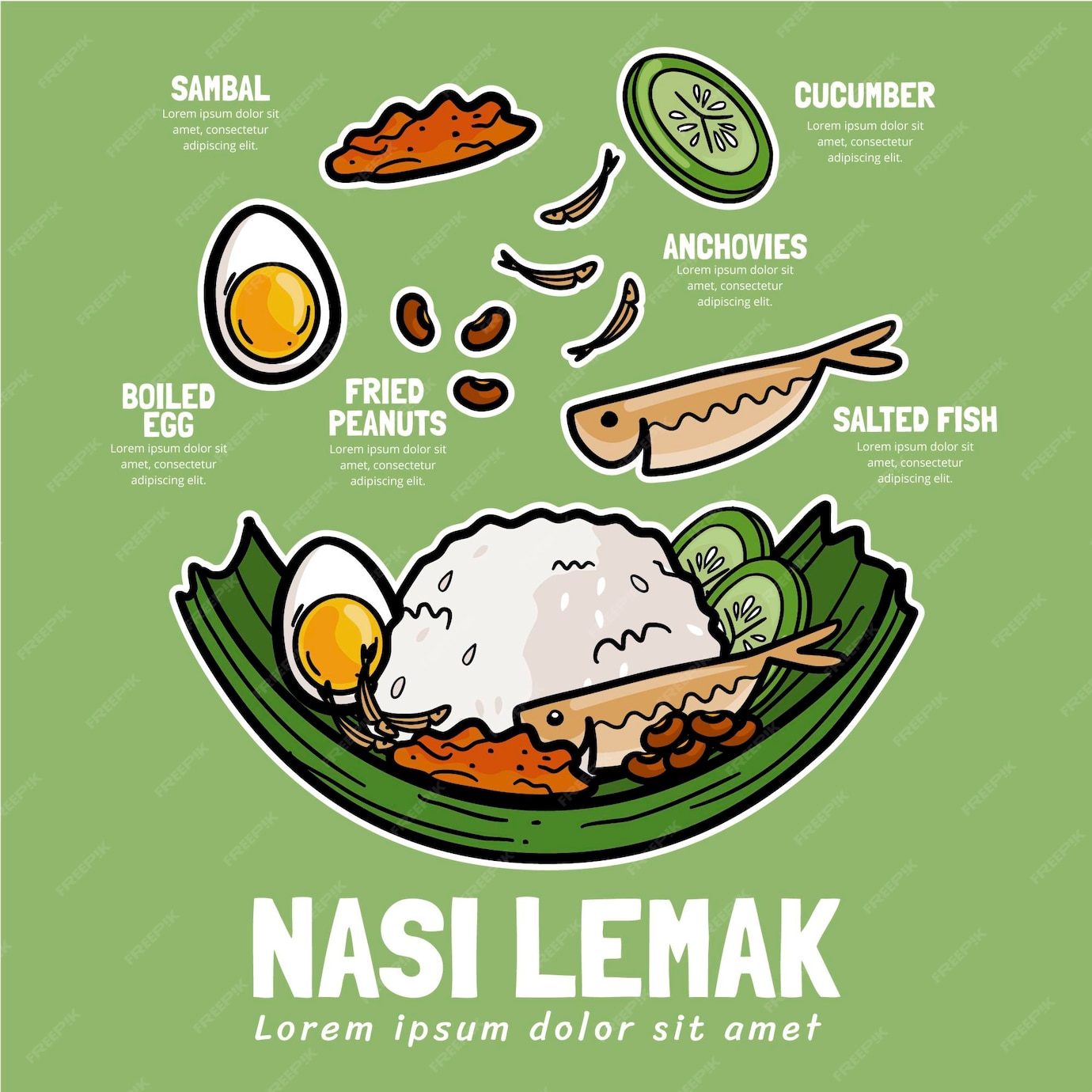The Tale of Malaysia’s All-Time Favorite Dish: Nasi Lemak
By Asyrul Izhar Abu Bakar
Introduction
Being a melting pot of cultures, Malaysia has established itself as a foodie’s paradise. When someone asks, “what is one of the most attractive things in Malaysia?” I would undoubtedly say the food. The diverse population of Malaysia has contributed greatly to the country’s rich food history, which is enjoyed by many. Despite the quick pace of modernization, the country has been able to successfully preserve her proud tradition. Therefore, Malaysia is one of the rare locations where a fusion of flavors and variations of traditional cuisine may be found in one place. Malaysian food reflects the country’s many cultures. Despite the fact that traditional Malaysian cuisine can be categorized as either Malay, Indian, Chinese, Nyonya (Peranakan), or Eurasian, there is a deep and complex history of cultural exchange, borrowing, adaptation, and hybridization throughout the country. One of the local delicacies that every race would definitely eat and enjoy whether it is for breakfast or dinner, is Nasi Lemak.

Nasi Lemak
What is Nasi Lemak?
Nasi lemak, one of the most versatile meals in Malaysia, is considered the country’s greatest culinary achievement. This simple yet delicious meal is widely available across the entire country of Malaysia, from the bustling metropolises to the outlying villages. It has become so popular in Malaysia that some people eat it every day to start their day. So basically, Nasi Lemak is a dish of rice cooked in coconut milk and served with a side of chili paste, also known as sambal, along with peanuts, eggs, fried anchovies and cucumber as condiments. All of these components of Nasi Lemak make it one of the most delicious yet fulfilling food. The word “Nasi Lemak” also translates to “rich rice,” referring to the extra richness of the coconut cream-cooked rice as opposed to plain water-cooked rice. Nasi Lemak is traditionally wrapped in a banana leaf as this way of packaging leads to a neater and more attractive meal.
The Origin of Nasi Lemak
As with many popular dish origin stories, there is no single “confirmed” origin, although there have been a variety of misconceptions around how this colorful meal came to be. We do know that this cuisine has its origins in Malaysian culture and history. The origin of Nasi Lemak could therefore be divided into three possibilities, which are explained below.
-
The Farmer’s Story
The Malay local communities believed that Nasi Lemak was created when the people who lived near the sea and farms used all of the ingredients that were available to them, such as coconuts and anchovies from the sea, and vegetables and eggs from their farms. All of these magical ingredients led to the creation of Nasi Lemak, which is perfect for the farmers as it not only satisfies their hunger but also provides all of the essential nutrients.
-
The Folklore Behind the Accidental Spill
We also have a more anecdotal origin myth: in a small village in Malacca, there lived a widow, Mak Kuntum, and her daughter named Seri. The widow had to work to support her small family, leaving her young daughter to cook. One day while preparing lunch for her family, Seri accidentally spilled some coconut milk into a boiling pot of rice. The narrative continues with Mak Kuntum returning home from work and inquiring about the fragrant rice. Seri replied, “Nasi le, mak!” (rice, mother!), and thus the name Nasi Lemak was born.
-
The Earliest Western Record
Aside from origin myths, Nasi Lemak can be traced back to 1909 when it was first mentioned in a book by a British colonial administrator and researcher Sir Richard Olaf Winstedt titled “The Circumstances of Malay Life,” published in 1909. He recounts how “the Malay cook” boiled rice in coconut milk for festivals and weddings, noting that this dish is known as “Nasi Lemak.”

Components of a Nasi Lemak
Evolvements of Nasi Lemak
As time goes by, the original recipe of Nasi Lemak is rapidly evolving. Various concepts have been implemented to enhance Nasi Lemak as the main actor in creating other delicious dishes. Locally, trends have emerged among a younger population that is more open and receptive to culinary innovations. Historically, Nasi Lemak was primarily sold on the roadside or in restaurants but nowadays fast food chains such as McDonald’s, Kentucky Fried Chicken (KFC) and Marry Brown have also included Nasi Lemak on their menus, as people really enjoy it as a part of their meal. Nasi Lemak Burger and Nasi Lemak ice cream have been introduced in food chain restaurants and cafes. For instance, in the case of Nasi Lemak ice cream, coconut milk was used as the base while strawberry sauce was added with a pinch of spiciness to symbolize the ‘sambal’ in Nasi Lemak. Supermarkets have also introduced products that adopt the concept of Nasi Lemak, such as Nasi Lemak paste and Nasi Lemak chips, offering consumers a convenient way to enjoy the taste of Nasi Lemak at their fingertips.

A Little Bit of Science Behind Nasi Lemak!
As mentioned above, banana leaves were used to pack or wrap the Nasi Lemak, but did you know there’s actually science involved behind it? Banana leaves have a natural waxy layer that insulates hot food better than plastic wrap. They can also withstand temperatures of up to 100 degrees, making them ideal for wrapping the meal and retaining the heat. Don’t worry, banana leaves also do not produce any chemicals when they come into contact with hot food. Therefor, your tummy will definitely be safe from any chemicals. Furthermore, a study conducted by Maidin and Latiff, reported in the Journal of Advanced Manufacturing Technology, reported that Nasi Lemak wrapped in banana leaves lasted longer compared to other forms of packaging (e.g. plastics). This is because the packaging allows for open-air flow, enabling the food to ‘breathe’.
A post by Dr. Yvonne Choo indicated that a lot of molecules play a particular role in producing the distinct fragrance of the Legendary Nasi Lemak. For instance, three main ingredients were incorporated in the recipe of Nasi Lemak: coconut milk, pandan (screwpine) leaves and ginger. What makes a Nasi Lemak a Nasi Lemak? It is definitely be THE AROMA of the rice. Delta lactones are the main molecules that contribute to the flavor and smell of the coconut milk, indirectly enhancing the rich and delicious aroma of Nasi Lemak. Those who love Nasi Lemak would certainly recognize its distinct gingery taste, which envelopes your taste buds in the aroma of ginger. Do you know what is actually happening? When the ginger is cooked together with the rice, the gingerols (a molecule present in ginger) are broken down into zingerone, giving the Nasi Lemak its gingery taste. Last but not least, another ingredient that would enhance the unique aroma of Nasi Lemak is pandan (screwpines) leaves. A molecule known as 2-acetyl-1-pyrroline (2AP) present in pandan leaves is also responsible for the fragrance of Nasi Lemak which makes it irresistible to everyone.
P/S: Just some additional info
Have you ever noticed that some Nasi Lemak can be white, blue or even green in color? What is actually happening is that some ingredients are added not only for aesthetic reasons, but also to enhance the properties of the Nasi Lemak itself. For instance, butterfly pea flowers are added to Nasi Lemak to give it a beautiful pale blue color and at the same time providing a high level of antioxidants which can offer extra health benefits to the consumers. On the other hand, infusing pandan in Nasi Lemak gives it a distinct pandan punch, which complements all the other components of Nasi Lemak, such as the chili paste (sambal), further enhancing the taste of a flavorful, fragrant and scrumptious Nasi Lemak.
References
- Image 1: https://pixabay.com/illustrations/food-nasi-lemak-malay-cuisine-8136451/
- Image 2: https://pixabay.com/photos/food-nasi-lemak-asia-malaysia-658715/
- Image 3: https://www.freepik.com/free-vector/hand-drawn-nasi-lemak-illustrated_13763606.htm#query=nasi%20lemak&position=20&from_view=search&track=ais
- Image 4: https://pixabay.com/illustrations/teacher-chemistry-science-scientist-4777244/
About the author
 Asyrul Izhar bin Abu Bakar was born in Malaysia. Asyrul obtained his Bachelor’s degree in Food Studies at University Putra Malaysia. During his undergraduate studies, he graduated with First Class of Honors and was offered a fast-track program to continue his PhD in University Putra Malaysia. His research focuses on meat and poultry processing and development of fat replacers to enhance the properties of food. Asyrul is a very enthusiastic food scientist and really loved the fact that science was involved in every single food that we ate today. He also now has 7 journal publications with 2 of them were from Q1 journals. On top of that, he is also known as a FOOD HUNTIST (Food Hunter + Food Scientist) as he really loves food hunting!
Asyrul Izhar bin Abu Bakar was born in Malaysia. Asyrul obtained his Bachelor’s degree in Food Studies at University Putra Malaysia. During his undergraduate studies, he graduated with First Class of Honors and was offered a fast-track program to continue his PhD in University Putra Malaysia. His research focuses on meat and poultry processing and development of fat replacers to enhance the properties of food. Asyrul is a very enthusiastic food scientist and really loved the fact that science was involved in every single food that we ate today. He also now has 7 journal publications with 2 of them were from Q1 journals. On top of that, he is also known as a FOOD HUNTIST (Food Hunter + Food Scientist) as he really loves food hunting!






Wow, the article provides such a fascinating insight into the world of Nasi Lemak! The blend of cultural history, origin myths, and the science behind its aroma is truly captivating. It’s amazing how Nasi Lemak has evolved over time, becoming a versatile and beloved dish. The details about the packaging using banana leaves and the science of its distinct fragrance add a whole new dimension to my appreciation for this culinary gem. I’m now inspired to explore the diverse variations, from Nasi Lemak ice cream to colored renditions. Thanks for sharing this delightful journey into the world of Malaysian cuisine!